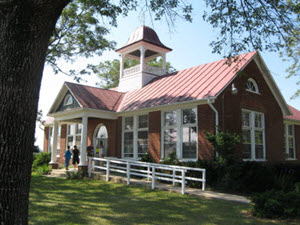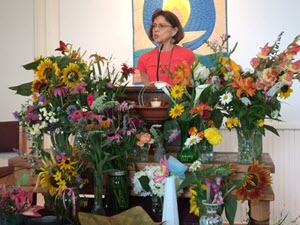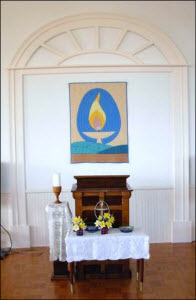
HUU Sermon Archives
Mythology
Patti Rose
September 25, 2004
My topic directly reflects the ideas of Joseph Campbell, and I will draw many of my ideas primarily from two sources, The Power of Myth and Thou Art That. My interest in this topic originates from a particular time and series of places.
As a mental exercise, allow me to describe the situation that led to my interest in mythology and my request to speak on it. Try to visualize a small, green Subaru hatchback with a single driver traveling the interstates of the South. Rolling past the kudzu-draped trees in South Carolina and Georgia, by huge swamps in Mississippi and Louisiana, and through long, desolate, flat stretches of Texas where the only sights were cacti, scrub brush, and an occasional oil well. The driver must past the long hours somehow, so she listens to about as much country radio as she can stand, then tries some of her CDs. Later she puts in a tape of the Dalai Lama but finds herself in such a meditative state that she can’t focus and the road becomes blurry. Aha! She says. What I need is mental stimulation to keep me alert and to pass the time. Fortunately a friend has lent her The Power of Myth, a set of six one-hour cassettes. As this is how I began this relationship with Joseph Campbell that has taken me to Texas and back and finally has brought me to speak before you today. What a long, strange trip it’s been.
As I listened to the tapes, I was so intrigued that I decided to buy the companion book to the series and three other books by Campbell. I even called Sarah from the road to say I was immersed in Joseph Campbell that I felt moved to give a sermon. She did not dissuade me as I later wished she had. Anyway, I discovered of course that this topic is so broad and Campbell wrote so much that I had trouble narrowing this thing down to something manageable. But I’ve done my best; so here goes.
For those of you who aren’t familiar with Joseph Campbell, a bit of background: Born in New York City in 1904, Joseph Campbell was an expert in fields varying from medieval literature to Sanskrit. He was a professor of literature at Sarah Lawrence College for many years. In addition to helping to translate the Upanishads, has published numerous books on a variety of topics. Campbell is perhaps most widely known for a series of interviews he had with Bill Moyers shortly before his death in 1987. Power of Myth, a six-hour PBS series and the companion book were the transcripts of those interviews. During the conversations Campbell and Moyers explored the history and scope of mythology.
Let’s start with Campbell’s definition of myth. “Myths are stories of our search through the ages for truth, for meaning, for significance.” “Myths,” he continued, “are clues to the spiritual potentialities of human life.” When asked how myths differ from dreams, he replied, “A dream is a personal experience of that deep, dark ground that is the support of our conscious lives, and a myth is society’s dream.”
Campbell was concerned with religions in which the metaphor is identified as fact. Rather than describing heaven and hell as place outside the self or describing God or gods as beings separate from humans, he said, “Heaven and hell are within us, and all the gods are within us. They are magnified dreams, and dreams are manifestations in the image form of the energies of the body in conflict with each other. That is what myth is. Myth is a manifestation in symbolic images, in metaphorical images, of the energies of the organs of the body in conflict with each other. The brain is one of those organs.”
Myths contain symbols. Two symbols Campbell described are the snake and the moon. The serpent sheds its skin to be born again, as the moon its shadow to be born again. They are equivalent symbols. The serpent represents immortal energy and consciousness engaged in the field of time, constantly throwing off death and being born again. As so, the serpent carries in itself the sense of both the fascination and the terror of life. Life lives by killing and eating itself, casting off death and being reborn, like the moon. In India even the most poisonous snake, the cobra, is a sacred animal and the mythological Serpent King is the next thing to Buddha. The serpent represents the power of life engaged in the field of time, and of death, yet eternally alive. The world is but its shadow—the falling skin. The serpent was revered in the American Indian traditions too.
“But in the Christian tradition, the serpent is the seducer, which amounts to a refusal to affirm life. In the biblical tradition we have inherited, life is corrupt, and every natural impulse is sinful unless it has been circumcised or baptized. The serpent is the one who brought sin to the world. And the woman was the one who handed the apple to man. This identification of the woman with sin, of the serpent with sin, and thus of life with sin, is the twist that has been given the whole story in the biblical myth and doctrine of the Fall. The idea of woman as sinner does not appear in other mythologies. So why are women the ones held responsible for the downfall? Because they represent life.”
Certainly symbols are part of our civil, social, and religious lives. They help define who we are as individuals and members of communities. In other words they’re valuable. As religious symbols, Campbell suggests the conflict comes when the symbols are seen in terms of prose instead of poetry, seeing the metaphor in terms of the denotation instead of the connotation. For example, the biblical flood being identified as a historical fact with archeologists searching for the remains of the ark rather than identifying it as a metaphor for destruction and renewal that is part of the cycle of life. Campbell criticizes the modern world in which “our thinking is largely discursive, verbal and linear,” where we have lost the art of thinking in images. That is why I think art, music, and poetry are essential to our existence. They provide a means to tap into the metaphorical dimension of our lives. They balance the technological, scientific thought that some say is true. In my mind, poetry and science are both true in the sense that they help us give meaning to our lives. Campbell said, “People say that what we’re all seeking is a meaning for life. I think what we’re seeking is an experience of being alive.” I agree.
So I’ve discussed myths, dreams, symbols, and metaphors. Now I’d like to explore a concept: the transcendent. Transcendent, according to Campbell, is “a technical, philosophical term, translated in two different ways. In Christian theology, it refers to God as being beyond or outside the field of nature.” He argues, “that is a materialistic way of talking about the transcendent because God is thought of as a kind of spiritual fact existing somewhere out there. ‘Transcendent’ properly means that which is beyond all concepts.” He goes on to say that “our senses are enclosed the field of time and space, and our minds are enclosed in a frame of the categories of thought. But the ultimate thing that we are trying to get in touch with is not so enclosed. We enclose it when we try to think of it. Whatever is ultimate is beyond the categories of being and nonbeing.” This statement led me to think of the Tao. Alan Watts translates the explanation of the Tao as
"The tao that can be told
is not the eternal Tao.
The name that can be named
is not the eternal Name.The unnameable is the eternally real.
Naming is the origin
Of all particular things.
Free from desire, you realize the mystery.
Caught in desire, you see
Only the manifestations."
When we put together myth, symbol, metaphor, and concepts like the transcendent, we get to mythology. “A whole mythology,” says Campbell, “is an organization of symbolic images and narratives metaphorical of the possibilities of human experience and the fulfillment of a given culture at a given time.” In other words, a mythology is a pattern of images and stories that symbolize the human experience for a particular culture at a specific time.
In several sources, Campbell outlines four functions which traditional mythology serves:
1. Mystical—“realizing what a wonder the universe is and what a wonder you are, and experiencing awe before this mystery. You are always addressing the transcendent mystery through the conditions of your actual world. The Zoroastrian religion presented the notion that the world was originally good and that an evil principle moved to precipitate a fall out of which came this unfortunate, unhappy , unintended situation known as the human condition. By following the doctrine of Zoroaster, people could associate themselves with the forces of restoration, eliminate the infection of evil and move on toward the good again. This mythology in broad terms found its way into the biblical tradition. But instead of blaming the fall on an evil principle antecedent to man, the biblical tradition blamed it on man himself.
Whether one thinks of the mythology in terms of the affirmation of the world as it is, the negation of the world as it is, or the restoration of the world to what it ought to be, the first function of mythology is to arouse in the mind a sense of awe before this situation through one of three ways of participating in it: by moving out, moving in, or effecting correction. The essentially religious function of mythology is this mystical function.”
2. Cosmological—this is the dimension with which science is concerned. “The whole universe, as we now understand it, becomes a revelation of the mystery dimension. Interpretive function of this dimension is to present a consistent image of the order of the cosmos. The bible reflects the cosmology of the third millennium BC”, which presents a problem for modern people who have scientific knowledge. When metaphors of the bible are believed as factual, incongruity exists.
3. Sociological –to support and validate certain specific moral orders, the order of the society out of which that mythology arose. Here’s where myths vary enormously from place to place. Through this function, mythology reinforces the moral order by shaping the person to the demands of a specific geographically and historically conditioned social group. The danger is when social institutions press on people mythological structures that no longer match their human experience. For example, when certain religious or political interpretations of human life are insisted upon, mythic dissociation can occur.”
4. Pedagogical—how to live a human lifetime under any circumstances. The purpose of this function is “to carry the individual through the various stages and crises of life—that is to help persons grasp the unfolding of life with integrity. This wholeness means that the individuals will experience significant events, from birth through midlife to death, as in accord with, first themselves, and secondly, with their culture, as well as, thirdly, the universe, and lastly, with the mystery beyond themselves and all things.”
So what then is the value of identifying the functions of these mythologies? Reading Joseph Campbell helped me to get a broader view of mythology. I am probably like many of you in the sense that once I rejected the idea of the Bible as historical fact, I dismissed the mythology altogether. Looking at it from a different perspective, metaphorically, I see that I can learn from the mythology. While I do not embrace the religion, I certainly understand those who do.
In preparation for today’s talk, I spoke with several colleagues who are Christian. I asked them whether they read the Bible literally or figuratively. All of them said they viewed it as a mixture of history and metaphor. They said the value of the metaphor was as a basis for morality and it gave some meaning to their lives. They also remarked that the ritual in their religious practice was important. I agree that ritual can bring a person into a sacred space or a place of contemplation. Participating in a ritual that is known and predictable is certainly comforting.
Another understanding I came to during my study is why I tend to be drawn to Eastern religious traditions. Campbell argues, in Western tradition the creator and the creature are separate. The goal “is not to bring about a sense of identity with the transcendent” but “to bring about a relationship between human beings and God, who are not the same.” This relationship is accomplished through the institution. In the Eastern traditions, “the real universe is the spiritual realm of the inner life.” Heaven and hell and good and evil exist within the self. In nature religions, the self is part of the cycle of life. Reaching the transcendent within is the way in which I experience spirituality.
But looking beyond myself as an individual, I agree with Campbell’s assertion that we need a new myth for our time. “The only myth that is going to be worth thinking about in the immediate future,” he stresses, “is one that is talking about the planet, not the city, not these people, but the planet, and everybody on it.” I agree that the way for humanity to survive is to seek a planetary mythology. I hope I’m part of it.
For the latest sermons and events at HUU, visit our Community Cafe.
Inclement
Weather Policy
Worship
Service Materials


UUs on YouTube
Our denomination has an official presence on YouTube! The Unitarian Universalist Association's YouTube site includes several videos and lots of interesting commentary.
Harrisonburg Unitarian Universalists 4101 Rawley Pike | Harrisonburg,
VA 22801
Mailing Address: | PO Box 96 | Harrisonburg, VA 22803
| (540) 867-0073 | Webmaster
HUU is a member of the Southern
Region of the Unitarian Universalist
Association
Privacy Policy &
Disclaimer
Site Design & Maintainence : Expression
Web Tutorials & Templates


